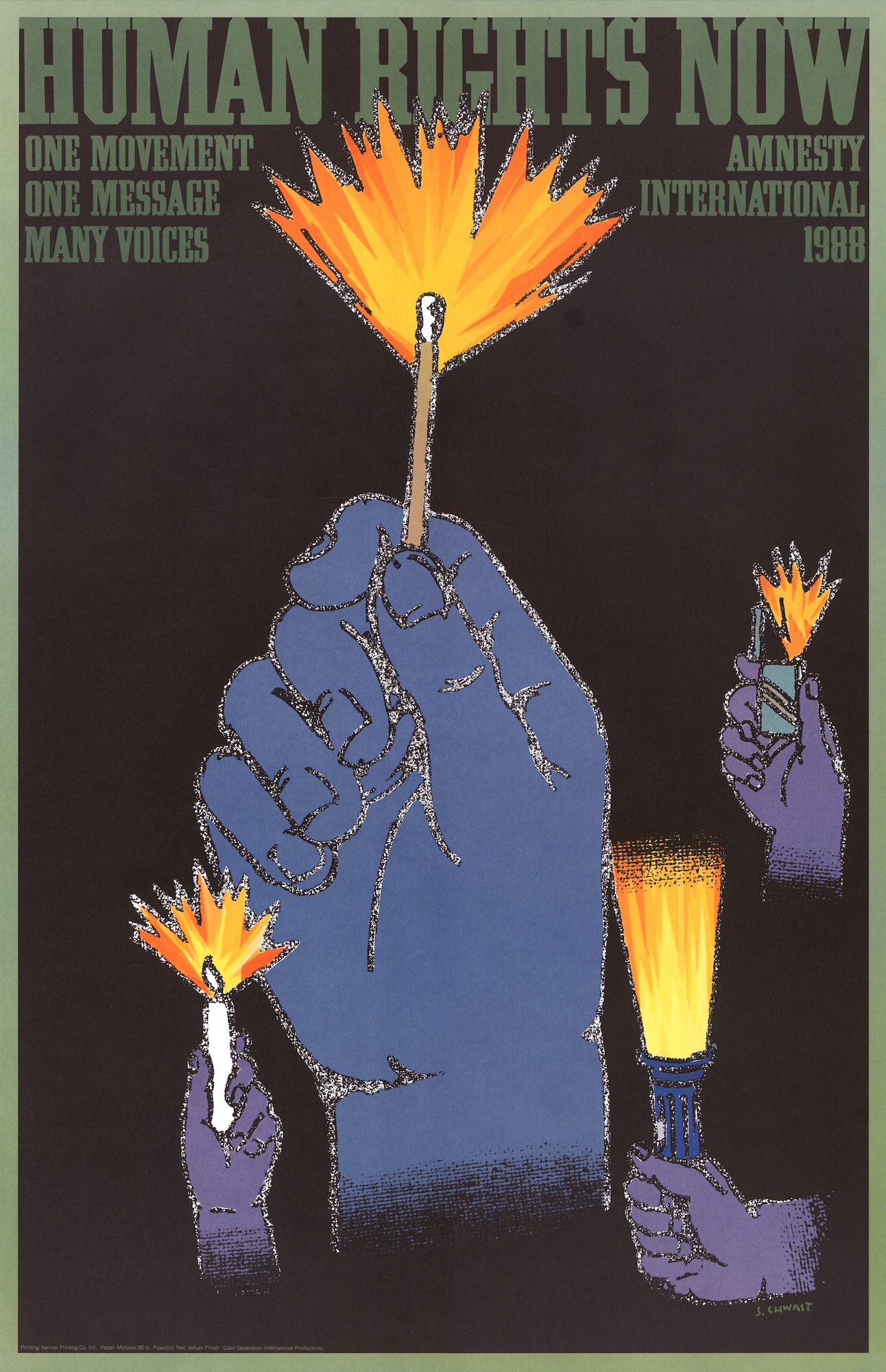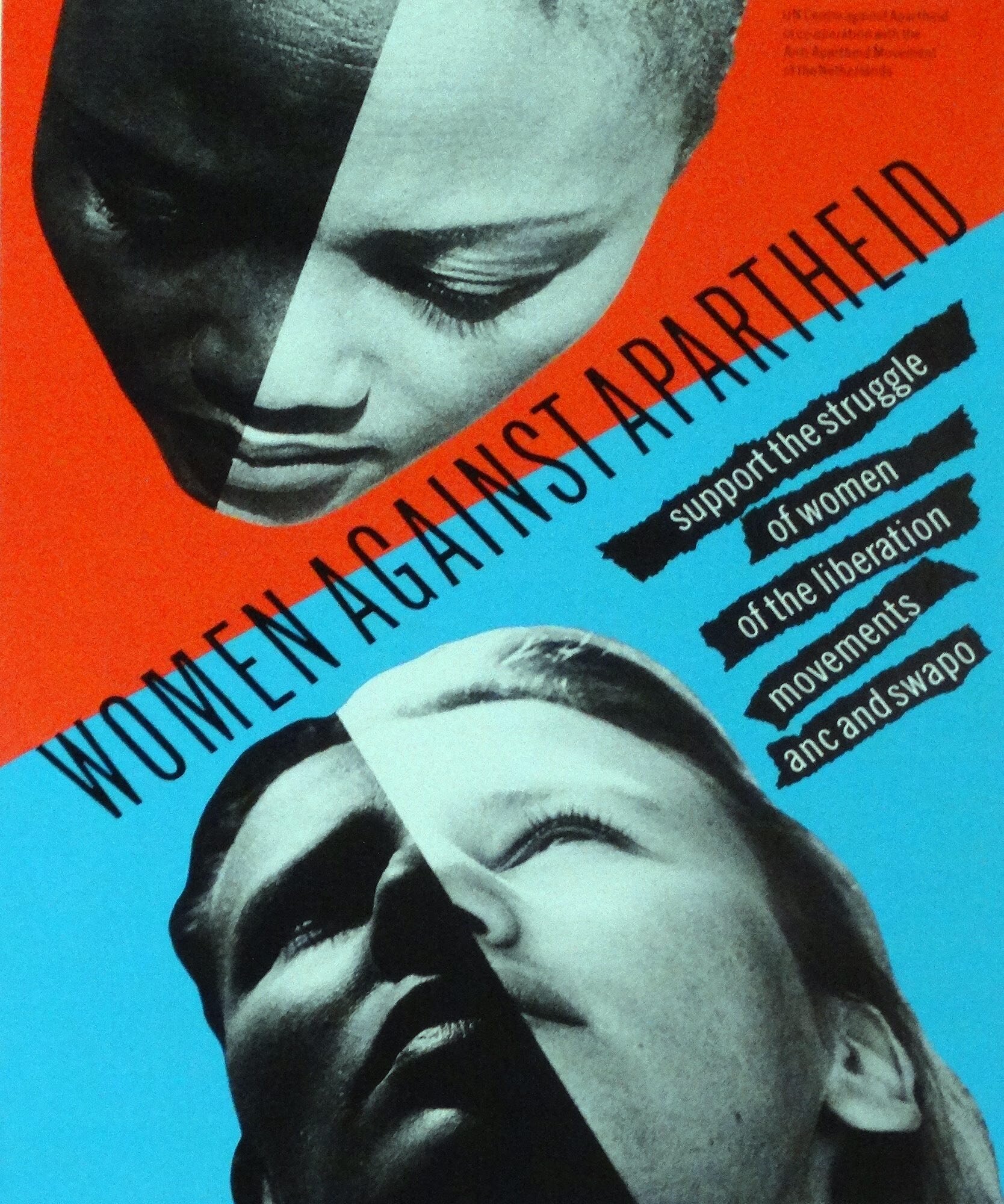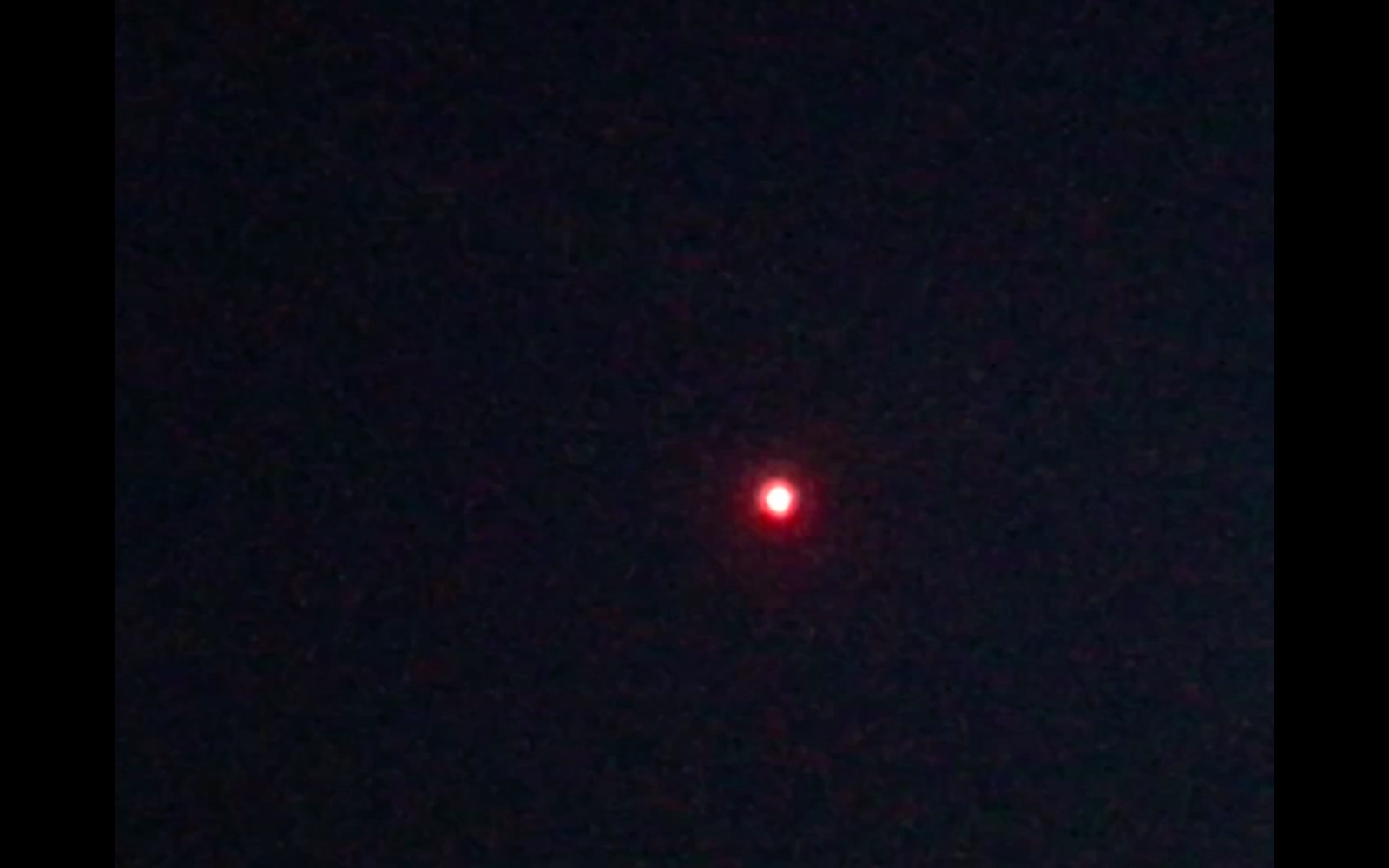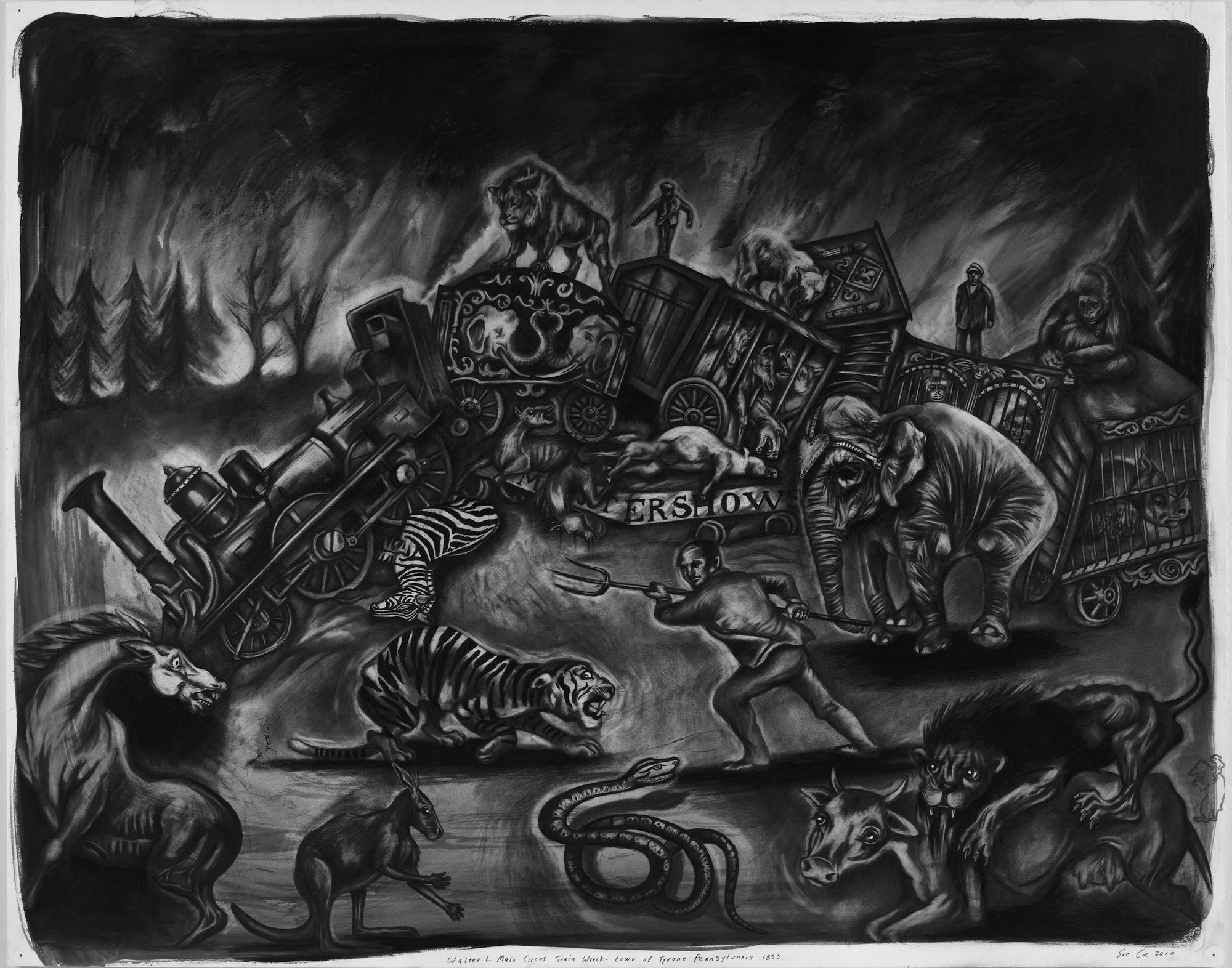The Art of Protest

A new book collects some of the most iconic protest artworks of the last 100 years
The Art of Protest is a new book published by Palazzo, in collaboration with Amnesty International, collecting more than 100 images of social protest from the early 20th century up to the present day. “The images in this book are a compendium of the will to a voice,” said artist Anish Kapoor “Collectively they declare a refusal to be looked at or judged from the outside.”
It covers key campaigns such as women’s liberation, nuclear disarmament, civil rights, the climate crisis, refugee rights and LGBTQ activism – we selected a few of our favourites, which you can see here.
One Movement, One Message, Many Voices. Seymour Chwast for Amnesty International 1988, USA. Credit: Amnesty International
Featuring a drawing from American graphic designer Seymour Chwast, this poster was produced for the Human Rights Now! campaign in 1988. Human Rights Now! was a worldwide campaign to increase awareness of Amnesty International and to commemorate the fortieth anniversary of the Universal Declaration of Human Rights.
Women Against Apartheid. Lies Ros, Frank Beekers, and Rob Schröder of Wild Plakken for Anti-Apartheids Beweging Nederland (AABN) 1984, Netherlands. Credit: Alamy/World History Archive
Wild Plakken was a Dutch design group formed in 1977 by former classmates from the Gerrit Rietveld Academie in Amsterdam. Its name means “wild pasting” and refers to the way the group pasted posters around Amsterdam illegally—Schroder was arrested several times—to bring attention to the political and social struggles of the time. Collective working was central to their operation, as was the belief that design should reflect the nature and content of the subject. The group favored collage, specifically photomontage, with juxtaposed images and bold, colorful shapes. The poster here specifically highlights the struggle under apartheid of women, who were subject not only to racial oppression, but also gender discrimination. Two female heads, each with a dark and a light-skinned half, exhibit the conflict of the apartheid system, while the text, “women against apartheid,” overlapping the blue and red represents the ultimate aim of unification.
Daddy, what did YOU do in the Climate War? Josh MacPhee, Justseeds, 2017, USA
Using the same play on guilt, a reworking of a British recruitment poster from 1915—“Daddy, what did YOU do in the Great War?” —forms the basis of this poster from Josh MacPhee, a founding member of artists’ collective Justseeds. It was produced for the 2017 People’s Climate March, held at the end of President Trump’s first one hundred days in office, to protest against his environmental policies. The father and his children are drawn wearing diving helmets as their living room fills with water—a visual allusion to the earth’s rising sea levels—and the use of the word “war” enforces the gravity of climate change upon the viewer. As MacPhee explains: “My goal is to both equate the seriousness of our current climate crisis with one of the bloodiest wars humans have seen, but also playfully jab at the extremes we tend to go to in order to pretend things are ‘normal.’ There is no normal any more.”
What a Woman may be, and yet not have the Vote. Suffrage Atelier c. 1913, UK Credit: Rex Shutterstock/Museum of London
The Suffrage Atelier was an artist collective that worked “to advance the women’s movement, and particularly the Enfranchisement of Women, by means of pictorial publications.” Formed in 1909, in Shepherd’s Bush, west London, by playwright Laurence Housman, his sister, artist Clemence Housman, and Alfred Pearse, a political cartoonist, the Suffrage Atelier also ran printmaking workshops and organized competitions for its members to submit work for use in the campaign. Posters were blockprinted from simple woodcuts and then colored by hand, meaning they could be created cheaply and quickly. In this poster, a series of “worthy” females including nurse, mayor, and doctor are juxtaposed with “unworthy” male counterparts such as drunkard and convict. Viewing the poster today, it is hard to argue in favor of the absurdity of the system of the time, and denying women the right to vote.
No One Is Illegal. Diptych, Josh MacPhee, Justseeds 2016, USA
Comprising two posters —“No Wall Unclimbed” and “No Fence Uncut” —this diptych was designed in support of resistance to controlling people’s movements. Josh MacPhee explains: “People move. This is a reality, plain and simple. It is criminalized and made painful, and even lethal, by the borders created by states, capitalism, and xenophobes.” The tag “No one is illegal” references the notion that declaring a human being illegal is in itself an illegal act by fact of the Universal Declaration of Human Rights (UDHR), which states that not only does everyone have the right to freedom of movement, but the right to a nationality and the right to seek asylum. However, under the International Covenant on Civil and Political Rights (ICCPR)—a companion to the UDHR— governments may restrict movement for reasons such as public safety, health, and order. This clause is often cited as justification of legal frameworks that many believe mask racist and oppressive policies, and the subsequent language used to describe immigrants, i.e. “illegal,” further criminalizes them.
No Draft. No War. No Nukes. Artist Unknown. 1970s–1980s, USA. Credit: Rex Shutterstock/Granger
Draft-card burning, a display of protest by conscientious objectors to the Vietnam War, was popular during the 1960s and 1970s in both the US and Australia. The first documented draft-card burning was by twenty-two-year old Eugene Keyes in December 1963 in Illinois. By 1965, it was a frequent occurrence, and the US government enacted harsher laws in a bid to limit its influence. Australia also repressed such protest until the Labor government came to power and abolished conscription in 1972. President Richard Nixon put an end to the US draft in 1973. This pop art poster shows the world’s most famous personification of freedom—the Statue of Liberty—holding aloft a burning draft card in protest at being conscripted to war, conveying a strong message about the right to personal freedom.
ACTIONS
Amnesty International is a UK-based NGO focused on human rights around the world, with over seven million supporters and members around the world – go check them out
The Art of Protest is published by Palazzo
Author account for the Good Trouble hive-mind.












